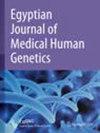Deciphering the landscape of lncRNA-driven ceRNA network in schizophrenia etiology
IF 1.2
Q4 GENETICS & HEREDITY
引用次数: 0
Abstract
The unifying hypothesis of competing endogenous RNA (ceRNA) wherein crosstalk between coding (mRNAs) and long non-coding RNAs (lncRNAs) via microRNA (miRNA) response elements, creates a pervasive regulatory network across the transcriptome, has been implicated in complex disorders including schizophrenia. Even with a wide range of high-throughput data, the etiology of schizophrenia remains elusive, necessitating a more holistic understanding of the altered genetic landscape, shifting focus from solely candidate gene studies and protein-coding variants. We developed lncRNA-associated ceRNA networks to elucidate global molecular/regulatory signatures underlying schizophrenia using diverse data in the public domain. Microarray dataset associated with peripheral blood mononuclear cells (PBMCs) of schizophrenia and control patients was used to identify differentially expressed mRNAs. Weighted gene co-expression network analysis (WGCNA) was used to identify highly correlated hubs, and genes from these overlapping Kyoto Encyclopedia of Genes and Genomes (KEGG) and gene ontology (GO) term genesets were considered key mRNA players. StarBase, Human MicroRNA Disease Database, and miRWalk were used to derive mRNA-miRNA and miRNA-lncRNA relationships. Finally, the key mRNAs, interacting lncRNAs and miRNAs were chosen to reconstruct sub-ceRNA networks based on network centrality scores. Bioinformatics analysis revealed the involvement of three differentially expressed mRNAs, namely ADRA1A, HAP1 and HOMER3 in the schizophrenia ceRNA networks with lncRNAs NEAT1, XIST, and KCNQ1OT1 modulating their activity by a suggestive sequestering of miR-3163, miR-214-3p and miR-2467-3p, respectively. Furthermore, based on contextual evidence, we propose how ceRNAs could orchestrate crosstalk between neurostructural dynamics and immune/inflammatory processes and enable unifying these disparate models of schizophrenia etiology.解密精神分裂症病因学中由 lncRNA 驱动的 ceRNA 网络结构
竞争性内源性 RNA(ceRNA)的统一假说认为,编码 RNA(mRNA)和长非编码 RNA(lncRNA)之间通过微 RNA(miRNA)反应元件的串扰,在整个转录组中形成了一个无处不在的调控网络,这一假说与包括精神分裂症在内的复杂疾病有关。即使拥有大量的高通量数据,精神分裂症的病因仍然难以捉摸,因此有必要对改变的遗传景观进行更全面的了解,将重点从单纯的候选基因研究和蛋白编码变异转移开来。我们利用公共领域的各种数据开发了与 lncRNA 相关的 ceRNA 网络,以阐明精神分裂症的全球分子/调控特征。与精神分裂症患者和对照组患者外周血单核细胞(PBMCs)相关的微阵列数据集用于识别差异表达的 mRNA。加权基因共表达网络分析(WGCNA)被用来识别高度相关的枢纽,这些重叠的京都基因与基因组百科全书(KEGG)和基因本体论(GO)术语基因组中的基因被认为是关键的 mRNA 参与者。StarBase、人类微RNA疾病数据库和miRWalk被用来推导mRNA-miRNA和miRNA-lncRNA的关系。最后,根据网络中心性得分,选择关键 mRNA、相互作用的 lncRNA 和 miRNA 重构子ceRNA 网络。生物信息学分析表明,ADRA1A、HAP1和HOMER3这三种差异表达的mRNA参与了精神分裂症ceRNA网络,而lncRNA NEAT1、XIST和KCNQ1OT1则分别通过miR-3163、miR-214-3p和miR-2467-3p的提示性序列化调节了它们的活性。此外,基于背景证据,我们提出了 ceRNAs 如何协调神经结构动态与免疫/炎症过程之间的串联,以及如何将这些不同的精神分裂症病因学模型统一起来。
本文章由计算机程序翻译,如有差异,请以英文原文为准。
求助全文
约1分钟内获得全文
求助全文
来源期刊

Egyptian Journal of Medical Human Genetics
Medicine-Genetics (clinical)
CiteScore
2.20
自引率
7.70%
发文量
150
审稿时长
18 weeks
 求助内容:
求助内容: 应助结果提醒方式:
应助结果提醒方式:


